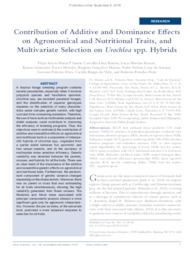Contribution of Additive and Dominance Effects on Agronomical and Nutritional Traits, and Multivariate Selection on Urochloa spp. Hybrids.
Contribution of Additive and Dominance Effects on Agronomical and Nutritional Traits, and Multivariate Selection on Urochloa spp. Hybrids.
Autoria: MATIAS, F. I.; BARRIOS, S. C. L.; BEARARI, L. M.; MEIRELES, K. G. X.; MATEUS, R. G.; AMARAL, P. N. C. do; ALVES, G. F.; VALLE, C. B. do; FRITSCHE-NETO, R.
Resumo: A tropical forage breeding program contains several peculiarities, especially when it involves polyploid species and facultative apomixis. Urochloa spp. are excellent perennial forages, and the identification of superior genotypes depends on the selection of many characteristics under complex genetic control, with high cost and time-consuming evaluation. Therefore, the use of tools such as multivariate analysis and diallel analyses could contribute to improving the efficiency of breeding programs. Thus, the objectives were to estimate (i) the contribution of additive and nonadditive effects on agronomical and nutritional traits in a population of interspecific hybrids of Urochloa spp., originated from a partial diallel between five apomictic and four sexual parents, and (ii) the accuracy of multivariate index selection efficiency. Genetic variability was detected between the parents, crosses, and hybrids for all the traits. There was no clear trend of the importance of the additive and nonadditive genetic effects on agronomical and nutritional traits. Furthermore, the predominant component of genetic variance changed depending on the characteristic. Moreover, there was no parent or cross that was outstanding for all traits simultaneously, showing the high variability generated from these crosses. The Mulamba and Mock index associated with principal components analysis allowed a more significant gain only for agronomic characteristics. However, the per se index, at the univariate level, promoted a more balanced response to selection for all traits.
Ano de publicação: 2018
Tipo de publicação: Artigo de periódico
Unidade: Embrapa Gado de Corte
Palavras-chave: Apomixia, Breeding, Controle Genético, Cruzamento Animal, Forrageira Tropical, Gramínea Perene, Grasslands, Hibrido, Hybrids, Livestock, Perennials, Polyploidy, Urochloa
Observações
1 - Por padrão são exibidas publicações dos últimos 20 anos. Para encontrar publicações mais antigas, configure o filtro ano de publicação, colocando o ano a partir do qual você deseja encontrar publicações. O filtro está na coluna da esquerda na busca acima.
2 - Para ler algumas publicações da Embrapa (apenas as que estão em formato ePub), é necessário ter, no celular ou computador, um desses softwares gratuitos. Sistemas Android: Google Play Livros; IOS: iBooks; Windows e Linux: software Calibre.
Acesse outras publicações
Acesse a Base de Dados da Pesquisa Agropecuária (BDPA) para consultar o acervo completo das bibliotecas da Embrapa.

